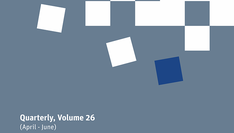Abstract
This research aimed to find facts on weaknesses and constraints that occurred in the field, and tried to prepare an alternative strategy model for supervising and empowering batik business to boost Purworejo’s community economic welfare. The research was held in a number of sub-regions which it was known as batik culture area in the past time. This research applied qualitative methods to obtain in-depth illustration on real situation and condition in the field. The result concluded that to develop and to empower Purworejo’s Batik, it was needed an alternative strategy, which included the comprehensive planning and supervising on batik industries in Purworejo. Batik craftsmen and business players were necessary to be empowered on business location, physical equipment, supporting goods, raw materials, products design, energy, manpower and time. Beside from the Government side, it was necessary such a strong political willingness on general policy and specially that aim for empowering and increase batik industry to become master in its own country.
References
Alma, B. (2010). Kewirausahaan. Bandung: Alfabeta.
Cooper, D. R., Schindler, P. S. (2000). Business Research Methods. 7th (Seven). Toronto: McGraw-Hill.
Day, G. S. (1999). Market Driven Strategy: Processes for Creating Value. New York: Free Press.
Denzin, N. K. and Lincoln, Y. S. (2009). Handbook of Qualitative Research. Yogyakarta: Pustaka Pelajar.
Goldstein, B. (2007). The Ultimate Small Business Marketing Toolkit: All the Tips, Forms, and Strategies You’ll Ever Need. 1st editio. Toronto: McGraw-Hill.
Griffin, R. W., Ebert, R. J. (2004). Business. Seventh Ed. New Jersey: Prentice-Hall, Pearson Education International.
Hastuti, T. D. and Sihombing, R. P. (2020). Analysis of Entrepreneurial Development of Natural Coloring Batik: A Case Study in Central Java Indonesia. "Journal of Business and Finance in Emerging Market", 2(2).
Hengky, S. (2018). Batik-Craft Tourism’s Competitiveness in Madura, Indonesia. "Journal of Management Research", 10(4). DOI: 10.5296/jmr.v10i4.13623.
Levy, M., Weitz, B. A. and Grewal, D. (2001). Retailing Management. Internatio. Toronto: McGrawHill Irwin.
Longenecker, J. G., Moore, C. W. and Petty, J. W. (1994). Small Business Management: An Entrepreneurial Emphasis. 12th editi. Ohio: South-Western College Pub.
Lubis, H., Rohmatillah, N., Rahmatina, D. (2020). Strategy of Tourism Village Development based on Local Wisdom. "Jurnal Ilmu Sosial dan Humaniora". DOI: 10.23887/jish-undiksha.v9i2.22385.
Moleong, L. J. (2017). Metodologi Penelitian Kualitatif (Edisi Revisi) [in:] PT. Remaja Rosda Karya.
Mulyani, N. S. et al. (2019). Implementation of Cultural Heritage in the Development of the Batik Industry in Ngawi Regency. "Universitas Sebelas Maret Repository".
Nitisusastro, M. (2010) Kewirausahaan & Manajemen Usaha Kecil. Bandung: Alfabeta.
Pudjowati, J. et al. (2019). The Influence of Business Network and SME Empowerment Towards Business Sustainability (Study of Handmade Mangrove Batik SME Surabaya). "Journal of Engineering and Applied Sciences". DOI: 10.36478/jeasci.2019.6625.6633.
Ricklefs, M. C. (2005). Sejarah Indonesia Modern 1200–2004. Jakarta: Serambi Ilmu Semesta.
Sari, S. R. et al. (2020). Value Chain Analysis on Handmade Batik Products. JEJAK. DOI: 10.15294/jejak.v13i1.21771.
Sigit, S. (2003). Pengantar Metodologi Penelitian Sosial-Bisnis Manajemen. Cetakan Ke. Yogyakarta: Penerbit Bagian Penerbitan Fakultas Ekonomi Universitas Sarjanawiyata Tamansiswa.
Siropolis, N. C. (1994). Small Business Management: A Guide to Entrepreneurship. 5th editio. Boston: Houghton Mifflin Co.
Sudja, W. A. (1979). Proses Pembuatan dan Pewarnaan Batik di Indonesia. Bandung: PT Karya Nusantara.
Sugiyono (2009). Metode Penelitian Kuantitatif, Kualitatif dan R&D. Bandung: Alfabeta.
Sugiyono (2016). Memahami Penelitian Kualitatif. Bandung: Alfabeta.
Suparno, S. et al. (2019). The Determinant Factors of Development Batik Cluster Business: Lesson From Pekalongan, Indonesia. "The Journal of Asian Finance, Economics and Business, 6(4). DOI: 10.13106/jafeb.2019.vol6.no4.227.
Suryani, I. E., Anggraeni, L. and Suryadi, U. (2015). Strategy Formulation for Developing Batik Tulis. "Indonesian Journal of Business and Entrepreneurship", 1(1). DOI: 10.17358/IJBE.1.1.23.
Widiana, M. E. et al. (2020). The Improving of the Quality Resources of Gedog Batik Craftsmen in Tuban Regency. "Indonesian Journal of Cultural and Community Development", 7. DOI: 10.21070/ijccd2020683.
Za, R. et al. (2019). Innovation and Marketing Strategy for Batik Products In The Industrial Age 4.0. "International Journal of Recent Technology and Engineering", 8(2S9). DOI 10.35940/ijrte.B1116.0982S919.
All texts published in the journal Modern Management Review are available in the full version on the website of MMR. Digital IDs have also been entered from number 19 (3/2012) (DOI: 10.7862/rz.2018.mmr.1)
Open Access – CC BY 4.0
This is an open access journal which means that all content is freely available without charge to the user or his/her institution. The articles are published under the terms of the Creative Commons licence (CC-BY 4.0), including the following fields of exploitation comprising:
1) the right to publish the Work in print in book and digital form and to distribute it in book and digital form, including by displaying, playing, broadcasting, making it publicly available by the Publisher and third parties,
2) the right to record and reproduce all or part of the Work on paper and in the form of a digital record and in any other possible way by the Publisher,
3) the right to enter the Work into computer memory and save the Work in the IT systems of the Publisher and other entities distributing digital content,
4) the right to archive the Work and make copies of the Work on electronic media by the Publisher, without quantitative restrictions,
5) the right to digitise the Work and to perform conversions/transformations of the Work in electronic form into other digital formats by the Publisher and third parties,
6) the right to distribute the Work, including via the Internet or other ICT networks by the Publisher and other third parties, in a way that allows viewing, reading, copying the content of the Work in electronic form, i.e. all elements belonging to it, whereby copying shall be understood as the saving of the Work made available to an interested person on a medium of their choice,
7) the right to store the Work in the database of the Publisher and other entities distributing the Work in any form, as well as its processing in the database of the Publisher and third parties,
8) right to translate and publish the Work in one of the modern languages in any form by the Publisher and third parties.


